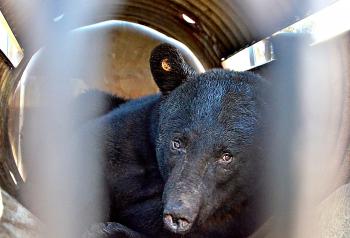
BEAR CAPTURED
A male Louisiana black bear was captured in a Wildlife and Fisheries trap in Patterson this morning after a likely night of foraging in a neighborhood a wildlife official called “an all-you-can-eat garbage buffet” for bears.
The bear, which had tags in both ears, indicating he had previous dealings with the state agency, was trapped at the Mike Drive home of Scott Vining.
Maria Davidson, Wildlife and Fisheries Large Carnivore Program manager, said this bear had been caught in Patterson in 2013 and relocated a short distance at that time.
Vining said he and his family had been seeing the bear frequently for about two weeks. He estimated the bear to be between three and four feet tall when standing on all fours and about seven-feet-tall when on two feet.
Davidson estimated that he would weigh between 200 and 250 pounds.
The bears use a trail from the woods through Vining’s yard and between he and his neighbor’s home to access the neighborhood.
Their goal? Garbage.
“There are multiple bears working the neighborhood … it’s an all-you-can-eat garbage buffet,” Davidson said.
The food scraps humans throw away are high in calories that bears need through the winter months when their natural food sources are scarce, according to Catherine Siracusa, parish black bear conflict officer.
Vining’s wife, Kay, said their three children are accustom to life with bears.
“When it gets dark, they come inside and are not allowed to go back out,” Kay Vining said.
Her neighbor, Jennifer Moore, added that part of life with bears is “picking up garbage all the time.”
Siracusa said the trap at Vining’s home and another on Tiffany Drive were placed because a bear broke a trash can on Tiffany Drive trying to get into it. Most homes in the area are equipped with bear-proof trash cans in an attempt to eliminate the temptation for a hungry bear, thus reducing the chances of an encounter with humans.
At mid-morning, a Wildlife and Fisheries biologist was at the Vining home to retrieve the bear.
Davidson said the bear would be relocated based on his sex and age. As a 3- or 4-year-old sub-adult male, relocating him to a better habitat doesn’t necessarily put him at greater risk for an accident if he attempts to return.
Male bears of this age roam in search of new territory, Davidson said, so he isn’t at higher risk of causing an accident while crossing a road than he would have naturally been.
“The important thing for residents to understand is relocating one bear does not fix the problem,” Davidson said, adding that residents need to do more to secure their garbage and avoid tempting the bears into the neighborhood.
Human garbage has 100 times more calories than what would be available in the natural environment, Davidson said.
“You can’t teach a bear not to eat … if they don’t find something to eat in the neighborhoods, they’re not going to come in,” Davidson said.
If removing the bear again doesn’t work to change his behavior and the bear becomes a public safety risk, “we will have to put him down,” she said.
- Log in to post comments
